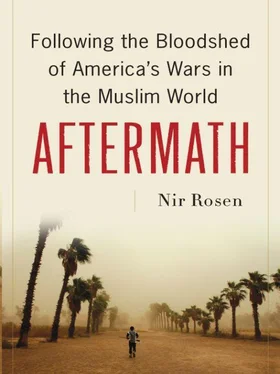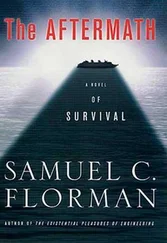In December 2007 the delegation of Americans led by Reineke was greeted warmly by Karim and his men. Five or six of his officers were with him, all Shiites. Reineke acted with exaggerated deference, saying “ naam seidi ” (yes, sir) repeatedly when addressing Karim. They discussed where they would place checkpoints and conduct joint patrols. Karim sought assurances that the ISV recruits had been properly vetted by local leaders, the Iraqi National Police, and the U.S. Army. Reineke mentioned that General Mustafa, a local ISV leader from Arab Jubur, had requested to open an office at the JSS. Karim grew tense. “The Awakening is a path for these individuals to get recruited by Iraqi Security Forces for jobs in the government,” he said. “More than that we don’t agree, the government is worried that these groups will be a militia or will be used by political groups.” Reineke tried to assure him that “the volunteers are only a short-term solution until they find jobs in the government.” Karim responded that “we have information that the Baath Party and Al Qaeda have infiltrated the Awakening. It’s very dangerous.” Reineke mentioned that in nearby Seidiya, the Awakening had opened an office. “The Awakening in Seidiya was killing people,” Karim said. “They are not yet in the government. We don’t accept that the Awakening will open an office. There is only one government. Those who qualify can join the police or the government, but the Awakening is temporary. There are two commands in this area: American and Iraqi. We won’t accept another.” The Iraqi general won the showdown.
A stern man named Abu Jaafar had been observing the exchange. Wearing a dark suit and a dark shirt buttoned up, with no tie, he had two thuggish companions in leather jackets who were very friendly with Karim. A Shiite known to the Americans as Sheikh Ali, Abu Jaafar had his own ISV unit of about 100 men in southern Dora’s Saha neighborhood. The Americans said he was unofficially in charge of that area. He was also a Neighborhood Advisory Council representative for Mahala 828. “He may not be Mahdi Army, but he has a lot of Mahdi Army friends,” Maj. Jeffrey Gottlieb whispered to me. He also had a lot of access to Karim’s headquarters.
“We’ve got a sectarian fault line in the Saha area,” Captain Cox explained to me that night, back at his base, drawing a line on the satellite image on the wall. “Saha was a battleground between [Al Qaeda in Iraq and the Mahdi Army]. We took over on September 8, 2007. The drop in violence is thanks to our unit moving in and patrolling every day.” Sunnis had been forced to rely on Al Qaeda for self-defense, he explained, and though northern Saha had been “an absolute killing zone before,” rich Sunnis were now trying to return.
Victims of sectarian killings were down by half since the 2-2 SCR had arrived, Cox said. “We can have meetings and agreements between prominent Shiites who had ties to militias and prominent Sunnis who had ties to AQ.” He sounded triumphant, but I couldn’t help noticing myself that attacks against Americans were also down to nearly zero when I was there.
But not far away, in Mahala 836, Cox admitted, a Shiite man was murdered when he went to check out his house after hearing it was safe to go back. The 2-2 SCR also noted a spike in criminal killings, they told me. I wondered how they could distinguish. The Mahdi Army cease-fire and the withdrawal of Al Qaeda forces to northern Iraq in order to avoid the surge created a power vacuum that allowed criminals to operate more freely.
A few days later I returned to meet with Karim without the Americans present and found him talking to several senior Shiite army officers about the forced displacement of Iraqis and what to do with the displaced. An Awakening member was living in a house that the original owner had sold to somebody else, and now the Awakening man refused to relinquish it to the new owner. “We need a mechanism to solve these problems,” one officer said. A colonel called Najam who spoke with a Shiite southern Iraqi dialect worried that displaced Sunnis had taken over former homes of Shiites in Dora. “We need to bring back the Shiites, but the Sunnis are in the houses,” he said. “This battle is bigger than the other battles—this is the battle of the displaced.” Eavesdropping, I could hear Najam angrily condemning somebody, presumably the Awakening. “They are killers, terrorists, ugly, pigs,” he said.
Karim’s phone rang, and he spoke with a superior officer about a clash the previous day between the Awakening and armed Shiites. “American officers took Awakening men to a sector where they shouldn’t be,” he said. “Residents saw armed men not in uniforms and shot at them from buildings. Four Awakening were injured. My battalion was called in to help.” In truth, they had clashed with the Mahdi Army, but Karim downplayed their role and blamed an American captain for establishing an ISV unit in an area where he should not have. “Yes, sir,” he said, “the Awakening will withdraw from that area. They started the problem.”
Gen. Abdul Amir, another man present, was the commander of the important Sixth Division of the Iraqi army. He warned that men were joining the Awakening for political purposes. “They want to be prominent in their neighborhood so that they will get elected. The prime minister said, ‘I don’t want this to be about politics, I want this to be about security.’”
The sectarian Shiite parties ruling Iraq worried about the Awakening becoming a pan-Iraqi movement. If it succeeded in being nonsectarian, it could displace them from power. Najam joked that 98 percent of the Awakening was Al Qaeda. Just then a U.S. Army major walked in and met with Karim outside the office. An embarrassed Karim returned and said he’d been informed he could not talk to me.
“Gen. Abdul Karim was a completely sectarian individual who was more interested in consolidating Shiite influence and power via his police than in really solving the problems that plagued the area,” an American captain confided to me. “He was also incompetent in that he did not at all understand how to run operations or how to collect and use intelligence. People were fairly scared of him, especially his own subordinates, which suggests he was connected to one Shiite militia or another, though this was never confirmed. I think it was unlikely that he was intimately involved in any particular militia, but only because that might create a problem for him. I remember once, while visiting our AOR [area of responsibility], his personal security detachment, a ridiculous thirty-plus policemen, provoked our ISVs into a confrontation and hauled several away to the INP HQ. It was a near nightmare getting them released, but the event was indicative of Karim’s belief that he controlled Dora and that only he would influence the security situation there.”
I returned on a different day to meet Abu Jaafar, who suggested Karim’s headquarters as a good location. Karim showed me a plaque on his wall that he said was an award from Prime Minister Maliki for being nonsectarian, and he pointed to medals on his desk that the Americans had given him—also, he said, for being nonsectarian. Next to them were a couple of traditional rings worn only by Shiites.
Before the war he had owned some minivans, he said. After the war he built the Shiite Imam al-Hassan Mosque in Saha. “When terrorist activities started in the area, I wasn’t involved,” he said, because it was not clear who was responsible. “When things got clear I saw that people needed somebody to lead them and command them according to God.” He explained that his men had taken the homes of “bad Sunnis” (meaning Al Qaeda) and inventoried their contents. “They don’t want to come back because they were killers,” he said. Problems in his area had started two years earlier, he said, with random assassinations. “My cousin was a school principal and a local council member, and he was shot to death walking home. And others were killed, and we didn’t know why or who killed them. After a while I knew that my neighbor was informing for the killers. Most of the dead were Shiites. I talked to the young men in our area and said, ‘If we don’t cooperate, we will be killed one by one.’ We started to guard our area.” Abu Jaafar and his militia used old refrigerators, cinder blocks, and earth to wall off their area. His enemies—Al Qaeda but also the 1920 Revolution Battalion and the Army of the Mujahideen—were, he claimed, these same people in the Awakening. Shiites did not need an Awakening. “We are already awake,” he said, smiling icily.
Читать дальше











